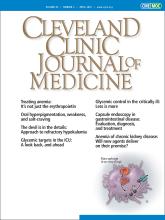Inpatient hyperglycemia is associated with significant morbidity and mortality, including in the intensive care unit (ICU). However, when it comes to optimal blood glucose targets, controversy abounds. In this issue, Alhatemi et al1 reflect on how we arrived at the current blood glucose targets and offer important insights on the future of glycemic monitoring and targets in critically ill patients.
See related article page 191
HISTORICAL INSIGHTS
While a number of studies reported the association between hyperglycemia and poorer outcomes for patients in the ICU, 2 studies in Leuven, Belgium,2,3 were the first to look at how achieving intensive glucose control affects clinical outcomes. The positive effect of glucose control on mortality and morbidity noted in those studies led to attempts to achieve even tighter glycemic control in patients in the ICU. But this movement came to a halt in 2009 with the publication of the Normoglycemia in Intensive Care Evaluation–Survival Using Glucose Algorithm Regulation (NICE-SUGAR) study,4 which demonstrated increased mortality in critically ill patients with intensive glucose control.
Alhatemi et al nicely outline the basic differences between the Leuven studies and the NICE-SUGAR study. It is worth noting that caloric intake was higher in the Leuven studies, which may have mitigated some of the hypoglycemia seen in the NICE-SUGAR study. Furthermore, there was less overlap in glucose values between the intensive-control and conventional-control groups in the Leuven studies than in the NICE-SUGAR study, which may have enhanced the detection of outcome differences in the Leuven studies.5
Ultimately, the divergent findings of these trials serve to highlight a very important point—that there may not be a one-size-fits-all approach to glycemic targets.
THE IMPORTANCE OF CONTEXT
The question that naturally arises then is whether there actually is a group of patients in the ICU who benefit from an intensive glucose control strategy? The answer appears to be that critically ill patients with well-controlled diabetes mellitus or without preexisting diabetes benefit from a more intensive glucose control strategy while, conversely, rapidly lowering glucose values in patients with poorer preadmission diabetes mellitus control is actually deleterious.
Egi et al6 examined how preexisting hyperglycemia influenced the association between glycemia and mortality in a study of 415 critically ill patients with diabetes. They found that in patients with higher preadmission hemoglobin A1c (> 7%), the higher the level of acute glycemia during the ICU stay, the lower the rate of in-hospital mortality as opposed to patients in the ICU with lower preadmission hemoglobin A1c levels (< 7%).
Naraba et al7 considered blood glucose target time-in-range (TIR) and 28-day mortality in 1,230 critically ill patients. In patients with a preadmission hemoglobin A1c < 6.5%, a lower TIR of 70 to 180 mg/dL was associated with increased mortality, an association not seen in patients with a hemoglobin A1c ≥ 6.5%.
While these trials suggest an interaction between preadmission glycemic state and response to intensive glucose control in patients in the ICU, the Glycemic Stability During the Intraoperative Period Among Patients With DM Undergoing CABG Surgery (GLUCO-CABG) study8 demonstrated this principle in prospective randomized fashion. Overall, intensive glucose control did not improve outcomes after cardiac surgery, but subsequent subgroup analysis revealed a lower rate of complications in patients without diabetes but with intensive glucose control. The physiologic basis for this is not clear, although one might postulate that there is a relative neuroglycopenia when patients with suboptimal glycemic control receive intensive glucose control.9
CONTINUOUS GLUCOSE MONITORING: THE FUTURE?
As Alhatemi et al1 point out, increasing attention is being paid to TIR and glycemic variability as targets for intervention for patients in the ICU. The studies done thus far on measurements of glycemic control have typically been extrapolated to TIR and glycemic variability from point-of-care glucose readings as opposed to using true continuous glucose monitoring.
An approach with the potential to significantly alter inpatient glycemic management is the use of current outpatient continuous glucose monitoring devices in the inpatient setting. Currently, 2 devices are approved for use in the hospital (GlucoScout and OptiScanner 5000).10 However, their availability in ICUs is limited, and they require a dedicated central or peripheral access for blood sampling. However, the COVID-19 pandemic has opened the doors to the testing and use of outpatient glucose monitoring devices in the hospital, showing that even in the ICU, outpatient devices can be used, although calibration is needed.11,12 This allows us to envision, in addition to telemetry for cardiac monitoring, the use of glucose tracings with alarms to monitor for hyperglycemia and hypoglycemia in hospital inpatients.
Much work still needs to be done to better understand the nuances of glycemic targets in critically ill patients, and to learn how to take advantage of evolving technology to improve appropriate glycemic control in the ICU.
DISCLOSURES
The author reports no relevant financial relationships which, in the context of her contributions, could be perceived as a potential conflict of interest.
- Copyright © 2022 The Cleveland Clinic Foundation. All Rights Reserved.






